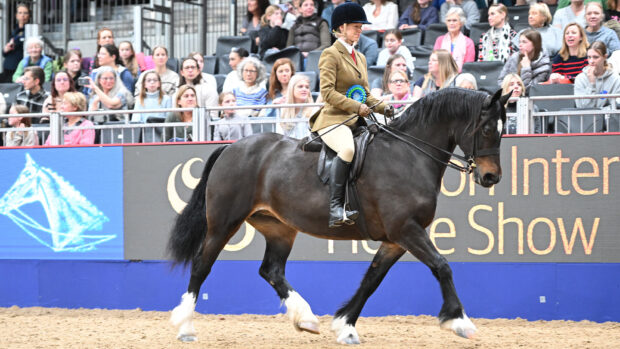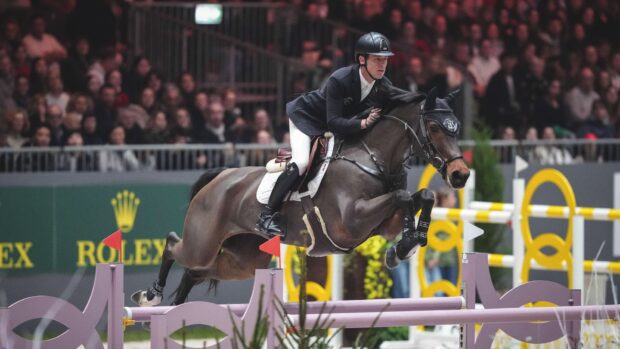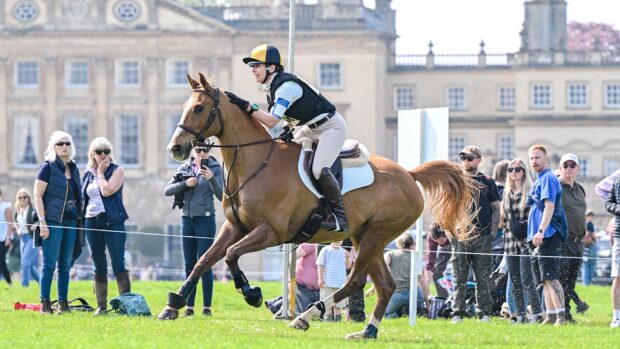The go-round can make or break your showing performance. It’s the judge’s first glimpse of your horse, and that first impression counts. Training at home for the go-round will be fundamental to your chances of success.
Whether you’re preparing a first ridden pony or a riding horse, the go-round is a defining part of the show ring experience. As showing producer and judge Stuart Hollings reminds us: “The go-round in showing is the first time the judge will see your horse, so it’s vital to give a good impression.”
That initial walk, trot, canter and extension in company (depending on what class you’re in) must be composed, confident and in harmony with your horse. The key to success? Preparation.
For many horses and ponies, the go-round can be unnerving at first. From becoming distracted or overly keen to spooking or crowding others, group riding presents a unique set of challenges.
{"content":"PHA+VGhlIGdvLXJvdW5kIGNvbnNpc3RzIG9mIHRoZSB3aG9sZSBjbGFzcyB3YWxraW5nLCB0cm90dGluZyBhbmQgY2FudGVyaW5nIHRvZ2V0aGVyLiBUaGUgc3Rld2FyZCB3aWxsIGluZGljYXRlIHdoZW4gdG8gY2hhbmdlIHRoZSByZWluLCBmb2xsb3dlZCBieSBjYW50ZXJpbmcgb24gdGhlIG9wcG9zaXRlIHJlaW4uIEluIHNvbWUgY2xhc3NlcywgeW91IG1heSBhbHNvIGJlIGFza2VkIGZvciBhbiBleHRlbnNpb24uIEFmdGVyIHRoaXMsIGNvbXBldGl0b3JzIGFyZSBhc2tlZCB0byB3YWxrLCBhbmQgdGhlIGp1ZGdlIHdpbGwgdXN1YWxseSBtYWtlIGFuIGluaXRpYWwgcHVsbCBvZiBwcmVmZXJlbmNlLCB3aGljaCB3aWxsIGRldGVybWluZSB0aGUgb3JkZXIgaW4gd2hpY2ggdGhlIGluZGl2aWR1YWwgc2hvd3Mgd2lsbCBiZSBwZXJmb3JtZWQuPC9wPgo8cD48c2VjdGlvbiBpZD0iZW1iZWRfY29kZS0zMSIgY2xhc3M9ImhpZGRlbi1tZCBoaWRkZW4tbGcgcy1jb250YWluZXIgc3RpY2t5LWFuY2hvciBoaWRlLXdpZGdldC10aXRsZSB3aWRnZXRfZW1iZWRfY29kZSBwcmVtaXVtX2lubGluZV8yIj48c2VjdGlvbiBjbGFzcz0icy1jb250YWluZXIgbGlzdGluZy0tc2luZ2xlIGxpc3RpbmctLXNpbmdsZS1zaGFyZXRocm91Z2ggaW1hZ2UtYXNwZWN0LWxhbmRzY2FwZSBkZWZhdWx0IHNoYXJldGhyb3VnaC1hZCBzaGFyZXRocm91Z2gtYWQtaGlkZGVuIj4NCiAgPGRpdiBjbGFzcz0icy1jb250YWluZXJfX2lubmVyIj4NCiAgICA8dWw+DQogICAgICA8bGkgaWQ9Im5hdGl2ZS1jb250ZW50LW1vYmlsZSIgY2xhc3M9Imxpc3RpbmctaXRlbSI+DQogICAgICA8L2xpPg0KICAgIDwvdWw+DQogIDwvZGl2Pg0KPC9zZWN0aW9uPjwvc2VjdGlvbj48L3A+CjxwPlN0dWFydCBIb2xsaW5ncyBhZHZpc2VzOiDigJxXaGVuIHlvdSByZXR1cm4gdG8gd2FsaywgcmVzaXN0IHRoZSB1cmdlIHRvIGNpcmNsZSB0aWdodGx5IGFyb3VuZCB0aGUganVkZ2UgaW4gdGhlIGhvcGUgb2YgYmVpbmcgbm90aWNlZC4gSW5zdGVhZCwgcG9zaXRpb24geW91cnNlbGYgaW4gYSBjbGVhciBzcGFjZSB3aGVyZSB5b3VyIGhvcnNlIGNhbiBzdGlsbCBiZSBzZWVuLiBJZiB5b3UgZW5kIHVwIHN0dWNrIGluIGEgaHVkZGxlLCB0aGVyZeKAmXMgZXZlcnkgY2hhbmNlIHlvdXIgYW5pbWFsIGNvdWxkIGJlIG92ZXJsb29rZWQu4oCdPC9wPgo8aDI+VHJhaW5pbmcgeW91ciBob3JzZSBmb3IgdGhlIGdvLXJvdW5kIGluIHNob3dpbmc8L2gyPgo8cD5UaGUga2V5IHRvIGEgc3VjY2Vzc2Z1bCBnby1yb3VuZCBpcyBwcmVwYXJhdGlvbi48L3A+CjxwPuKAnE15IGJlc3QgYWR2aWNlIGlzIHRvIHJpZGUgYXQgaG9tZSB3aXRoIGFzIG1hbnkgcGVvcGxlIGFzIHBvc3NpYmxlLOKAnSBzYXlzIHRvcCBwcm9kdWNlciBTYXJhIFBhcnJvdHQuIOKAnEdldCB1c2VkIHRvIHRoaW5raW5nIGFoZWFkIGFuZCBhbnRpY2lwYXRpbmcgd2hhdCBvdGhlcnMgYXJlIGRvaW5nIGFyb3VuZCB5b3Uu4oCdPC9wPgoKPHA+QnkgcmVwbGljYXRpbmcgdGhlIHJpbmcgZXhwZXJpZW5jZSBpbiB5b3VyIHRyYWluaW5nIGVudmlyb25tZW50LCB5b3UgY2FuIGJ1aWxkIHlvdXIgaG9yc2XigJlzIGNvbmZpZGVuY2UgYW5kIHRlYWNoIHRoZW0gdG8gZm9jdXMsIGV2ZW4gaW4gYSBidXN5IGFyZW5hLjwvcD4KPHA+PGRpdiBpZD0iYXR0YWNobWVudF84OTQ0NzMiIHN0eWxlPSJ3aWR0aDogMTQxMHB4IiBjbGFzcz0id3AtY2FwdGlvbiBhbGlnbm5vbmUiPjxpbWcgZmV0Y2hwcmlvcml0eT0iaGlnaCIgZGVjb2Rpbmc9ImFzeW5jIiBhcmlhLWRlc2NyaWJlZGJ5PSJjYXB0aW9uLWF0dGFjaG1lbnQtODk0NDczIiBjbGFzcz0ibGF6eWxvYWQgYmx1ci11cCBzaXplLWZ1bGwgd3AtaW1hZ2UtODk0NDczIiBkYXRhLXByb2Nlc3NlZCBzcmM9Imh0dHBzOi8va2V5YXNzZXRzLnRpbWVpbmN1ay5uZXQvaW5zcGlyZXdwL2xpdmUvd3AtY29udGVudC91cGxvYWRzL3NpdGVzLzE0LzIwMTcvMDMvbmV3LWhoLXBsYWNlaG9sZGVyLTIwMHgyMDAucG5nIiBkYXRhLXNyYz0iaHR0cHM6Ly9rZXlhc3NldHMudGltZWluY3VrLm5ldC9pbnNwaXJld3AvbGl2ZS93cC1jb250ZW50L3VwbG9hZHMvc2l0ZXMvMTQvMjAyNS8wNS9IQUgwMC5sYl9KZXNzVGFsYm90X1BCLkplc3NUYWxib3RfSW5UaGVTY2hvb2xfMzU5LmpwZyIgYWx0PSJDYW50ZXJpbmcgaW4gYSBidXN5IGFyZW5hIGFsb25nc2lkZSBvdGhlciBob3JzZXMgaXMgZ3JlYXQgdHJhaW5pbmcgZm9yIHRoZSBnby1yb3VuZCBpbiBzaG93aW5nIiB3aWR0aD0iMTQwMCIgaGVpZ2h0PSI3ODgiIGRhdGEtc2l6ZXM9ImF1dG8iIGRhdGEtc3Jjc2V0PSJodHRwczovL2tleWFzc2V0cy50aW1laW5jdWsubmV0L2luc3BpcmV3cC9saXZlL3dwLWNvbnRlbnQvdXBsb2Fkcy9zaXRlcy8xNC8yMDI1LzA1L0hBSDAwLmxiX0plc3NUYWxib3RfUEIuSmVzc1RhbGJvdF9JblRoZVNjaG9vbF8zNTkuanBnIDE0MDB3LCBodHRwczovL2tleWFzc2V0cy50aW1laW5jdWsubmV0L2luc3BpcmV3cC9saXZlL3dwLWNvbnRlbnQvdXBsb2Fkcy9zaXRlcy8xNC8yMDI1LzA1L0hBSDAwLmxiX0plc3NUYWxib3RfUEIuSmVzc1RhbGJvdF9JblRoZVNjaG9vbF8zNTktMzAweDE2OS5qcGcgMzAwdywgaHR0cHM6Ly9rZXlhc3NldHMudGltZWluY3VrLm5ldC9pbnNwaXJld3AvbGl2ZS93cC1jb250ZW50L3VwbG9hZHMvc2l0ZXMvMTQvMjAyNS8wNS9IQUgwMC5sYl9KZXNzVGFsYm90X1BCLkplc3NUYWxib3RfSW5UaGVTY2hvb2xfMzU5LTYzMHgzNTUuanBnIDYzMHcsIGh0dHBzOi8va2V5YXNzZXRzLnRpbWVpbmN1ay5uZXQvaW5zcGlyZXdwL2xpdmUvd3AtY29udGVudC91cGxvYWRzL3NpdGVzLzE0LzIwMjUvMDUvSEFIMDAubGJfSmVzc1RhbGJvdF9QQi5KZXNzVGFsYm90X0luVGhlU2Nob29sXzM1OS0xMzV4NzYuanBnIDEzNXcsIGh0dHBzOi8va2V5YXNzZXRzLnRpbWVpbmN1ay5uZXQvaW5zcGlyZXdwL2xpdmUvd3AtY29udGVudC91cGxvYWRzL3NpdGVzLzE0LzIwMjUvMDUvSEFIMDAubGJfSmVzc1RhbGJvdF9QQi5KZXNzVGFsYm90X0luVGhlU2Nob29sXzM1OS0zMjB4MTgwLmpwZyAzMjB3LCBodHRwczovL2tleWFzc2V0cy50aW1laW5jdWsubmV0L2luc3BpcmV3cC9saXZlL3dwLWNvbnRlbnQvdXBsb2Fkcy9zaXRlcy8xNC8yMDI1LzA1L0hBSDAwLmxiX0plc3NUYWxib3RfUEIuSmVzc1RhbGJvdF9JblRoZVNjaG9vbF8zNTktNjIweDM0OS5qcGcgNjIwdywgaHR0cHM6Ly9rZXlhc3NldHMudGltZWluY3VrLm5ldC9pbnNwaXJld3AvbGl2ZS93cC1jb250ZW50L3VwbG9hZHMvc2l0ZXMvMTQvMjAyNS8wNS9IQUgwMC5sYl9KZXNzVGFsYm90X1BCLkplc3NUYWxib3RfSW5UaGVTY2hvb2xfMzU5LTkyMHg1MTguanBnIDkyMHcsIGh0dHBzOi8va2V5YXNzZXRzLnRpbWVpbmN1ay5uZXQvaW5zcGlyZXdwL2xpdmUvd3AtY29udGVudC91cGxvYWRzL3NpdGVzLzE0LzIwMjUvMDUvSEFIMDAubGJfSmVzc1RhbGJvdF9QQi5KZXNzVGFsYm90X0luVGhlU2Nob29sXzM1OS0xMjIweDY4Ny5qcGcgMTIyMHciIHNpemVzPSIobWF4LXdpZHRoOiAxNDAwcHgpIDEwMHZ3LCAxNDAwcHgiIC8+PHAgaWQ9ImNhcHRpb24tYXR0YWNobWVudC04OTQ0NzMiIGNsYXNzPSJ3cC1jYXB0aW9uLXRleHQiPkNhbnRlcmluZyBpbiBhIGJ1c3kgYXJlbmEgYWxvbmdzaWRlIG90aGVyIGhvcnNlcyBpcyBncmVhdCByZWFsLWxpZmUgcHJhY3RpY2UgZm9yIHRoZSBnby1yb3VuZC4gQ3JlZGl0OiBQaGlsaXAgQmFya2VyPC9wPjwvZGl2PjxiciAvPgo8L3A+CjxwPklmIHlvdXIgcG9ueSB0ZW5kcyB0byBjaGFzZSwgU2FyYSBzdWdnZXN0cyBmb2N1c2luZyBvbiDigJxmaW5kaW5nIHdheXMgdG8ga2VlcCB0aGVpciBhdHRlbnRpb24sIGZvciBleGFtcGxlLCBoYWxmLWhhbHRzIGFuZCBzbGlnaHQgYmVuZGluZyBleGVyY2lzZXMgdGhhdCBjYW4gYmUgdXNlZCBpbiB0aGUgcmluZyBpZiBuZWVkZWTigJ0uPC9wPgo8cD5NYWludGFpbmluZyBhIHNvZnQgaW5zaWRlIGJlbmQgaW4gY29ybmVycyBjYW4gYWxzbyBoZWxwIHRvIGtlZXAgeW91ciBob3JzZeKAmXMgZm9jdXMgb24geW91LCByYXRoZXIgdGhhbiBvbiB3aGF04oCZcyBoYXBwZW5pbmcgb3V0c2lkZSB0aGUgcmluZy48L3A+Cgo8cD5EZXNlbnNpdGlzYXRpb24gaXMgYW5vdGhlciBrZXkgZWxlbWVudC4gQ2xpbmljcywgb3V0aW5ncyBhbmQgaGFja2luZyBpbiBjb21wYW55IGFsbCBwcm92aWRlIHZhbHVhYmxlIGV4cGVyaWVuY2UuPC9wPgo8cD7igJxHbyB0byBsb3RzIG9mIGRpZmZlcmVudCBwbGFjZXMs4oCdIGFkZHMgU2FyYS4g4oCcSXQgaGVscHMgZ2V0IHRoZW0gdXNlZCB0byBuZXcgZW52aXJvbm1lbnRzLuKAnTwvcD4KPHA+VGhpcyBleHBvc3VyZSBoZWxwcyB5b3VyIGhvcnNlIHN0YXkgY2FsbSBhbmQgcmVzcG9uc2l2ZSwgZXZlbiB3aGVuIGZhY2VkIHdpdGggY3Jvd2RzLCBiYW5uZXJzLCBub2lzZSBhbmQgdW5mYW1pbGlhciBzdXJyb3VuZGluZ3MuPC9wPgo8aDI+VHJhaW5pbmcgeW91ciBob3JzZSBmb3IgdGhlIGdvLXJvdW5kIGluIHNob3dpbmc8L2gyPgo8aDM+UmluZ2NyYWZ0IGFuZCByaWRlciBhd2FyZW5lc3M8L2gzPgo8cD5Gb3IgdGhlIHJpZGVyLCBzdHJvbmcgcmluZ2NyYWZ0IGNhbiBtZWFuIHRoZSBkaWZmZXJlbmNlIGJldHdlZW4gYmxlbmRpbmcgaW50byB0aGUgYmFja2dyb3VuZCBhbmQgY2F0Y2hpbmcgdGhlIGp1ZGdl4oCZcyBleWUuIEl0IHN0YXJ0cyB0aGUgbW9tZW50IHlvdSBlbnRlciB0aGUgcmluZy48L3A+CjxwPkZpcnN0LCBkb27igJl0IHJ1c2ggdG8gZ28gaW4g4oCTIG1ha2Ugc3VyZSB5b3UgZ2l2ZSB5b3Vyc2VsZiBzdWZmaWNpZW50IHNwYWNlIGJldHdlZW4geW91IGFuZCB0aGUgaG9yc2UgaW4gZnJvbnQuPC9wPgo8cD5QYXVsIENvb2ssIDxhIGhyZWY9Imh0dHBzOi8vd3d3LmhvcnNlYW5kaG91bmQuY28udWsvdGFnL2JzcHMiIHRhcmdldD0iX2JsYW5rIiByZWw9Im5vZm9sbG93IG5vb3BlbmVyIj5Ccml0aXNoIFNob3cgUG9ueSBTb2NpZXR5PC9hPiBjaGFpcm1hbiBhbmQganVkZ2UsIHJlbWluZHMgcmlkZXJzIG5vdCB0byBvdmVybG9vayB0aGUgYmFzaWNzOiDigJxEb27igJl0IHVuZGVyZXN0aW1hdGUgdGhlIHBvd2VyIG9mIGEgZ29vZCB3YWxrLiBJdOKAmXMgdGhlIGZpcnN0IGltcHJlc3Npb24gdGhlIGp1ZGdlIGhhczsgaXQgc2hvdWxkbuKAmXQgYmUgaGVsZCBpbiBhbmQgdGlnaHQsIGJ1dCBhIGZyZWUgd2FsayBpbiBhIGNvcnJlY3Qgb3V0bGluZSB3aXRoIHB1cnBvc2Uu4oCdPC9wPgo8ZGl2IGlkPSJhdHRhY2htZW50Xzg5NDQ4MSIgc3R5bGU9IndpZHRoOiAxNDEwcHgiIGNsYXNzPSJ3cC1jYXB0aW9uIGFsaWdubm9uZSI+PGltZyBkZWNvZGluZz0iYXN5bmMiIGFyaWEtZGVzY3JpYmVkYnk9ImNhcHRpb24tYXR0YWNobWVudC04OTQ0ODEiIGNsYXNzPSJsYXp5bG9hZCBibHVyLXVwIHNpemUtZnVsbCB3cC1pbWFnZS04OTQ0ODEiIGRhdGEtcHJvY2Vzc2VkIHNyYz0iaHR0cHM6Ly9rZXlhc3NldHMudGltZWluY3VrLm5ldC9pbnNwaXJld3AvbGl2ZS93cC1jb250ZW50L3VwbG9hZHMvc2l0ZXMvMTQvMjAxNy8wMy9uZXctaGgtcGxhY2Vob2xkZXItMjAweDIwMC5wbmciIGRhdGEtc3JjPSJodHRwczovL2tleWFzc2V0cy50aW1laW5jdWsubmV0L2luc3BpcmV3cC9saXZlL3dwLWNvbnRlbnQvdXBsb2Fkcy9zaXRlcy8xNC8yMDI1LzA1L0hBSDAwLmxiX3N0b2NrYXV0dW1uMjEuQXJlbmFfV2lkZV9BbmdsZV80UjJBNjE3Ny5qcGciIGFsdD0iV2Fsa2luZyBwcmFjdGljZSBpcyBhbiBpbXBvcnRhbnQgcGFydCBvZiB0cmFpbmluZyBmb3Igc2hvd2luZyIgd2lkdGg9IjE0MDAiIGhlaWdodD0iNzg4IiBkYXRhLXNpemVzPSJhdXRvIiBkYXRhLXNyY3NldD0iaHR0cHM6Ly9rZXlhc3NldHMudGltZWluY3VrLm5ldC9pbnNwaXJld3AvbGl2ZS93cC1jb250ZW50L3VwbG9hZHMvc2l0ZXMvMTQvMjAyNS8wNS9IQUgwMC5sYl9zdG9ja2F1dHVtbjIxLkFyZW5hX1dpZGVfQW5nbGVfNFIyQTYxNzcuanBnIDE0MDB3LCBodHRwczovL2tleWFzc2V0cy50aW1laW5jdWsubmV0L2luc3BpcmV3cC9saXZlL3dwLWNvbnRlbnQvdXBsb2Fkcy9zaXRlcy8xNC8yMDI1LzA1L0hBSDAwLmxiX3N0b2NrYXV0dW1uMjEuQXJlbmFfV2lkZV9BbmdsZV80UjJBNjE3Ny0zMDB4MTY5LmpwZyAzMDB3LCBodHRwczovL2tleWFzc2V0cy50aW1laW5jdWsubmV0L2luc3BpcmV3cC9saXZlL3dwLWNvbnRlbnQvdXBsb2Fkcy9zaXRlcy8xNC8yMDI1LzA1L0hBSDAwLmxiX3N0b2NrYXV0dW1uMjEuQXJlbmFfV2lkZV9BbmdsZV80UjJBNjE3Ny02MzB4MzU1LmpwZyA2MzB3LCBodHRwczovL2tleWFzc2V0cy50aW1laW5jdWsubmV0L2luc3BpcmV3cC9saXZlL3dwLWNvbnRlbnQvdXBsb2Fkcy9zaXRlcy8xNC8yMDI1LzA1L0hBSDAwLmxiX3N0b2NrYXV0dW1uMjEuQXJlbmFfV2lkZV9BbmdsZV80UjJBNjE3Ny0xMzV4NzYuanBnIDEzNXcsIGh0dHBzOi8va2V5YXNzZXRzLnRpbWVpbmN1ay5uZXQvaW5zcGlyZXdwL2xpdmUvd3AtY29udGVudC91cGxvYWRzL3NpdGVzLzE0LzIwMjUvMDUvSEFIMDAubGJfc3RvY2thdXR1bW4yMS5BcmVuYV9XaWRlX0FuZ2xlXzRSMkE2MTc3LTMyMHgxODAuanBnIDMyMHcsIGh0dHBzOi8va2V5YXNzZXRzLnRpbWVpbmN1ay5uZXQvaW5zcGlyZXdwL2xpdmUvd3AtY29udGVudC91cGxvYWRzL3NpdGVzLzE0LzIwMjUvMDUvSEFIMDAubGJfc3RvY2thdXR1bW4yMS5BcmVuYV9XaWRlX0FuZ2xlXzRSMkE2MTc3LTYyMHgzNDkuanBnIDYyMHcsIGh0dHBzOi8va2V5YXNzZXRzLnRpbWVpbmN1ay5uZXQvaW5zcGlyZXdwL2xpdmUvd3AtY29udGVudC91cGxvYWRzL3NpdGVzLzE0LzIwMjUvMDUvSEFIMDAubGJfc3RvY2thdXR1bW4yMS5BcmVuYV9XaWRlX0FuZ2xlXzRSMkE2MTc3LTkyMHg1MTguanBnIDkyMHcsIGh0dHBzOi8va2V5YXNzZXRzLnRpbWVpbmN1ay5uZXQvaW5zcGlyZXdwL2xpdmUvd3AtY29udGVudC91cGxvYWRzL3NpdGVzLzE0LzIwMjUvMDUvSEFIMDAubGJfc3RvY2thdXR1bW4yMS5BcmVuYV9XaWRlX0FuZ2xlXzRSMkE2MTc3LTEyMjB4Njg3LmpwZyAxMjIwdyIgc2l6ZXM9IihtYXgtd2lkdGg6IDE0MDBweCkgMTAwdncsIDE0MDBweCIgLz48cCBpZD0iY2FwdGlvbi1hdHRhY2htZW50LTg5NDQ4MSIgY2xhc3M9IndwLWNhcHRpb24tdGV4dCI+VGhlIHdhbGsgaXMgYW4gaW1wb3J0YW50IHBhY2UgdGhhdCB0aGUganVkZ2VzIHdpbGwgbm90aWNlLCBwZXJmZWN0IGl0IGF0IGhvbWUgc28gdGhhdCBpdCBzaG93cyBwdXJwb3NlIGFuZCBmcmVlZG9tIGluIHRoZSBnby1yb3VuZC4gQ3JlZGl0OiBBbmRyZXcgU3lkZW5oYW08L3A+PC9kaXY+CjxwPkluIHRoZSBnby1yb3VuZCwgeW91ciBqb2IgaXMgdG8gc2hvdyB5b3VyIGhvcnNlIHRvIGJlc3QgZWZmZWN0LCB3aXRob3V0IGRpc3J1cHRpbmcgb3RoZXJzLiBUaGF0IG1lYW5zIG1haW50YWluaW5nIHJoeXRobSBhbmQgYmVpbmcgY29uc3RhbnRseSBhd2FyZSBvZiB5b3VyIHNwYWNpbmcuPC9wPgo8cD7igJxJZiB5b3VyIGhvcnNlIGlzIGZhc3RlciBvciBoYXMgYSBiaWdnZXIgc3RyaWRlLCBvciB5b3UgZmVlbCBib3hlZCBpbiwgdGhpbmsgYWhlYWQs4oCdIGFkdmlzZXMgUGF1bC4g4oCcVHVybiBhIGNpcmNsZSBvciBjdXQgYWNyb3NzIHRoZSByaW5nIHRvIGZpbmQgYSBnYXAu4oCdPC9wPgo8cD5JZiB5b3UgbmVlZCB0byBvdmVydGFrZSwgYWx3YXlzIGRvIHNvIGNhcmVmdWxseS4gUmlkZSBvbiB0aGUgaW5zaWRlIHdpdGhvdXQgYmxvY2tpbmcgdGhlIGp1ZGdl4oCZcyB2aWV3IG9mIGEgZmVsbG93IGNvbXBldGl0b3IgYW5kIGF2b2lkIHVuc2V0dGxpbmcgb3RoZXIgY29tYmluYXRpb25zLjwvcD4KPHA+4oCcSXQgc2hvdWxkIG5ldmVyIGZlZWwgcnVzaGVkLOKAnSBzYXlzIERlYmJpZSBTcGVhcmUsIFNob3dpbmcgUmVnaXN0ZXIgY29vcmRpbmF0b3IgYW5kIGp1ZGdlLiDigJxZb3Ugd2FudCBhIHJlbGF4ZWQgcGljdHVyZSBpbiB5b3VyIGhvcnNl4oCZcyBuYXR1cmFsIHN0cmlkZS7igJ08L3A+CjxwPldoZW4gdGhlIHN0ZXdhcmQgY2FsbHMgZm9yIGEgY2FudGVyIGNoYW5nZSBhY3Jvc3MgdGhlIGRpYWdvbmFsLCBrZWVwIGl0IGNhbG0gYW5kIGJhbGFuY2VkLjwvcD4KPHA+4oCcRG9u4oCZdCBwdXNoIHlvdXIgYW5pbWFsIG91dCBvZiByaHl0aG0gYWNyb3NzIHRoZSBkaWFnb25hbCBiZXR3ZWVuIGNhbnRlcnMs4oCdIGFkZHMgRGViYmllLiDigJxFdmVyeXRoaW5nIHNob3VsZCBiZSBzbW9vdGggYW5kIGluIHR1bmUu4oCdPC9wPgo8cD5WaWNreSBTbWl0aCwgYSBwcm9saWZpYyA8YSBocmVmPSJodHRwczovL3d3dy5ob3JzZWFuZGhvdW5kLmNvLnVrL3RhZy9ob3lzI2hveXMiIHRhcmdldD0iX2JsYW5rIiByZWw9Im5vZm9sbG93IG5vb3BlbmVyIj5Ib3JzZSBvZiB0aGUgWWVhciBTaG93PC9hPiB3aW5uZXIsIGVtcGhhc2lzZXMgdGhhdCBwb2xpc2ggaXMgd2hhdCBtYWtlcyB0aGUgZGlmZmVyZW5jZS48L3A+CjxwPuKAnEp1ZGdlcyB3YW50IHRvIHNlZSBhIHdlbGwtc2Nob29sZWQsIHRyYWluZWQgYW5pbWFsLOKAnSBzaGUgc2F5cy4g4oCcVGhlIGp1ZGdlIG9ubHkgc2VlcyBhIHNob3J0IHBhcnQgb2YgeW91IGdvIHJvdW5kLCBzbyBpdCBzaG91bGQgbG9vayByZWxheGVkIGFuZCBpbiB0dW5lLiBJZiB5b3UgbmVlZCB0byBnaXZlIGEgaGFsZi1oYWx0IG9yIHJlYWRqdXN0LCB0cnkgdG8gZG8gaXQgb24gdGhlIHNpZGUgb2YgdGhlIHJpbmcgdGhlIGp1ZGdlIGlzbuKAmXQgbG9va2luZyBhdC7igJ08L3A+CjxwPklmIHlvdXIgaG9yc2UgYmVjb21lcyBzaGFycCBtaWQgZ28tcm91bmQsIHJpZGUgdGFjdGZ1bGx5LiBVc2Ugc3VidGxlIGhhbGYtaGFsdHMgYW5kIHN0YXkgY29tcG9zZWQuIERvbuKAmXQgbGV0IGEgc21hbGwgbWlzdGFrZSBkZWZpbmUgeW91ciByb3VuZC48L3A+CjxwPuKAnEtlZXAgY2FsbSwgcmlkZSBmb3J3YXJkIGFuZCBhaW0gdG8gZmluaXNoIHN0cm9uZ2VyLOKAnSBhZHZpc2VzIFNhcmEuPC9wPgo8aDI+U2hvd2luZyBwcmVzZW5jZSBhbmQgY29uZmlkZW5jZSBpbiB0aGUgZ28tcm91bmQ8L2gyPgo8cD5BIHBvbGlzaGVkIHBpY3R1cmUgY29tZXMgbm90IG9ubHkgZnJvbSBwcmVwYXJhdGlvbiwgYnV0IGFsc28gZnJvbSByaWRlciBwcmVzZW5jZS48L3A+CjxwPuKAnEhhcHB5IHBvbmllcyBhbmQgaGFwcHkgcGVvcGxlIG1ha2UganVkZ2VzIHNtaWxlLOKAnSBzYXlzIERlYmJpZS4g4oCcWW91IHdhbnQgdGhlIGp1ZGdlIHRvIHRoaW5rIHlvdSBoYXZlIHRoZSBiZXN0IGFuaW1hbCwgc28gcmlkZXIgY29uZmlkZW5jZSBpcyBpbXBvcnRhbnQu4oCdPC9wPgo8cD5Mb29raW5nIGxpa2UgeW914oCZcmUgZW5qb3lpbmcgdGhlIG1vbWVudCwgd2hpbGUgY2FsbWx5IG1hbmFnaW5nIHlvdXIgaG9yc2UsIGNyZWF0ZXMgdGhlIGtpbmQgb2YgcmluZyBwcmVzZW5jZSB0aGF0IGp1ZGdlcyBub3RpY2UuPC9wPgo8ZGl2IGlkPSJhdHRhY2htZW50Xzg5NDQ4MyIgc3R5bGU9IndpZHRoOiAxNDEwcHgiIGNsYXNzPSJ3cC1jYXB0aW9uIGFsaWdubm9uZSI+PGltZyBkZWNvZGluZz0iYXN5bmMiIGFyaWEtZGVzY3JpYmVkYnk9ImNhcHRpb24tYXR0YWNobWVudC04OTQ0ODMiIGNsYXNzPSJsYXp5bG9hZCBibHVyLXVwIHNpemUtZnVsbCB3cC1pbWFnZS04OTQ0ODMiIGRhdGEtcHJvY2Vzc2VkIHNyYz0iaHR0cHM6Ly9rZXlhc3NldHMudGltZWluY3VrLm5ldC9pbnNwaXJld3AvbGl2ZS93cC1jb250ZW50L3VwbG9hZHMvc2l0ZXMvMTQvMjAxNy8wMy9uZXctaGgtcGxhY2Vob2xkZXItMjAweDIwMC5wbmciIGRhdGEtc3JjPSJodHRwczovL2tleWFzc2V0cy50aW1laW5jdWsubmV0L2luc3BpcmV3cC9saXZlL3dwLWNvbnRlbnQvdXBsb2Fkcy9zaXRlcy8xNC8yMDI1LzA1L0hBSDUxNS5zaHdfY29sb3VyZWQubGVhZF9pbWFnZV93aW5uZXJfcndoc192aWNreV9zbWl0aF9jaHluYXNfdG9wX2RlY2tfdGhlX2NvbG91cmVkX3JpZGRlbl9jaGFtcGlvbnNoaXBfY2hhbXBpb25zaGlwXzEzLmpwZyIgYWx0PSJDb2xvdXJlZCBob3JzZSBjaGFtcGlvbiBpbiB0aGUgc2hvdyByaW5nIiB3aWR0aD0iMTQwMCIgaGVpZ2h0PSI4MTQiIGRhdGEtc2l6ZXM9ImF1dG8iIGRhdGEtc3Jjc2V0PSJodHRwczovL2tleWFzc2V0cy50aW1laW5jdWsubmV0L2luc3BpcmV3cC9saXZlL3dwLWNvbnRlbnQvdXBsb2Fkcy9zaXRlcy8xNC8yMDI1LzA1L0hBSDUxNS5zaHdfY29sb3VyZWQubGVhZF9pbWFnZV93aW5uZXJfcndoc192aWNreV9zbWl0aF9jaHluYXNfdG9wX2RlY2tfdGhlX2NvbG91cmVkX3JpZGRlbl9jaGFtcGlvbnNoaXBfY2hhbXBpb25zaGlwXzEzLmpwZyAxNDAwdywgaHR0cHM6Ly9rZXlhc3NldHMudGltZWluY3VrLm5ldC9pbnNwaXJld3AvbGl2ZS93cC1jb250ZW50L3VwbG9hZHMvc2l0ZXMvMTQvMjAyNS8wNS9IQUg1MTUuc2h3X2NvbG91cmVkLmxlYWRfaW1hZ2Vfd2lubmVyX3J3aHNfdmlja3lfc21pdGhfY2h5bmFzX3RvcF9kZWNrX3RoZV9jb2xvdXJlZF9yaWRkZW5fY2hhbXBpb25zaGlwX2NoYW1waW9uc2hpcF8xMy0zMDB4MTc0LmpwZyAzMDB3LCBodHRwczovL2tleWFzc2V0cy50aW1laW5jdWsubmV0L2luc3BpcmV3cC9saXZlL3dwLWNvbnRlbnQvdXBsb2Fkcy9zaXRlcy8xNC8yMDI1LzA1L0hBSDUxNS5zaHdfY29sb3VyZWQubGVhZF9pbWFnZV93aW5uZXJfcndoc192aWNreV9zbWl0aF9jaHluYXNfdG9wX2RlY2tfdGhlX2NvbG91cmVkX3JpZGRlbl9jaGFtcGlvbnNoaXBfY2hhbXBpb25zaGlwXzEzLTYzMHgzNjYuanBnIDYzMHcsIGh0dHBzOi8va2V5YXNzZXRzLnRpbWVpbmN1ay5uZXQvaW5zcGlyZXdwL2xpdmUvd3AtY29udGVudC91cGxvYWRzL3NpdGVzLzE0LzIwMjUvMDUvSEFINTE1LnNod19jb2xvdXJlZC5sZWFkX2ltYWdlX3dpbm5lcl9yd2hzX3ZpY2t5X3NtaXRoX2NoeW5hc190b3BfZGVja190aGVfY29sb3VyZWRfcmlkZGVuX2NoYW1waW9uc2hpcF9jaGFtcGlvbnNoaXBfMTMtMTM1eDc4LmpwZyAxMzV3LCBodHRwczovL2tleWFzc2V0cy50aW1laW5jdWsubmV0L2luc3BpcmV3cC9saXZlL3dwLWNvbnRlbnQvdXBsb2Fkcy9zaXRlcy8xNC8yMDI1LzA1L0hBSDUxNS5zaHdfY29sb3VyZWQubGVhZF9pbWFnZV93aW5uZXJfcndoc192aWNreV9zbWl0aF9jaHluYXNfdG9wX2RlY2tfdGhlX2NvbG91cmVkX3JpZGRlbl9jaGFtcGlvbnNoaXBfY2hhbXBpb25zaGlwXzEzLTMyMHgxODYuanBnIDMyMHcsIGh0dHBzOi8va2V5YXNzZXRzLnRpbWVpbmN1ay5uZXQvaW5zcGlyZXdwL2xpdmUvd3AtY29udGVudC91cGxvYWRzL3NpdGVzLzE0LzIwMjUvMDUvSEFINTE1LnNod19jb2xvdXJlZC5sZWFkX2ltYWdlX3dpbm5lcl9yd2hzX3ZpY2t5X3NtaXRoX2NoeW5hc190b3BfZGVja190aGVfY29sb3VyZWRfcmlkZGVuX2NoYW1waW9uc2hpcF9jaGFtcGlvbnNoaXBfMTMtNjIweDM2MC5qcGcgNjIwdywgaHR0cHM6Ly9rZXlhc3NldHMudGltZWluY3VrLm5ldC9pbnNwaXJld3AvbGl2ZS93cC1jb250ZW50L3VwbG9hZHMvc2l0ZXMvMTQvMjAyNS8wNS9IQUg1MTUuc2h3X2NvbG91cmVkLmxlYWRfaW1hZ2Vfd2lubmVyX3J3aHNfdmlja3lfc21pdGhfY2h5bmFzX3RvcF9kZWNrX3RoZV9jb2xvdXJlZF9yaWRkZW5fY2hhbXBpb25zaGlwX2NoYW1waW9uc2hpcF8xMy05MjB4NTM1LmpwZyA5MjB3LCBodHRwczovL2tleWFzc2V0cy50aW1laW5jdWsubmV0L2luc3BpcmV3cC9saXZlL3dwLWNvbnRlbnQvdXBsb2Fkcy9zaXRlcy8xNC8yMDI1LzA1L0hBSDUxNS5zaHdfY29sb3VyZWQubGVhZF9pbWFnZV93aW5uZXJfcndoc192aWNreV9zbWl0aF9jaHluYXNfdG9wX2RlY2tfdGhlX2NvbG91cmVkX3JpZGRlbl9jaGFtcGlvbnNoaXBfY2hhbXBpb25zaGlwXzEzLTEyMjB4NzA5LmpwZyAxMjIwdyIgc2l6ZXM9IihtYXgtd2lkdGg6IDE0MDBweCkgMTAwdncsIDE0MDBweCIgLz48cCBpZD0iY2FwdGlvbi1hdHRhY2htZW50LTg5NDQ4MyIgY2xhc3M9IndwLWNhcHRpb24tdGV4dCI+VGhlIGVwaXRvbWUgb2YgcHJlc2VuY2UgYW5kIHBvbGlzaDogVmlja3kgU21pdGgsIHBpY3R1cmVkIGFib2FyZCBSb3lhbCBXaW5kc29yIDIwMjUgY29sb3VyZWQgY2hhbXBpb24gQ2h5bmFzIFRvcCBEZWNrLCBzYXlzOiDigJxKdWRnZXMgd2FudCB0byBzZWUgYSB3ZWxsLXNjaG9vbGVkLCB0cmFpbmVkIGFuaW1hbC7igJ0gQ3JlZGl0OiBFbGxpIEJpcmNoL0Jvb3RzYW5kaG9vdmVzPC9wPjwvZGl2Pgo8cD5JbiBzb21lIGNsYXNzZXMsIGNvbWJpbmF0aW9ucyBtYXkgYmUgYXNrZWQgZm9yIGFuIGV4dGVuc2lvbiwgc29tZXRpbWVzIHNwbGl0IGludG8gdHdvIGdyb3Vwcy4gVGhlIHN0ZXdhcmQgd2lsbCBpbmRpY2F0ZSBpZiB0aGUganVkZ2Ugd291bGQgbGlrZSB0byBzZWUgYW4gZXh0ZW5zaW9uLiBJdOKAmXMgdml0YWwgdG8gbGlzdGVuIGNhcmVmdWxseSB0byB0aGUgaW5zdHJ1Y3Rpb25zIGZyb20gdGhlIHN0ZXdhcmQgb3IganVkZ2UuPC9wPgo8cD5BcyBTdHVhcnQgSG9sbGluZ3MgcG9pbnRzIG91dDog4oCcTGlzdGVuIHZlcnkgY2FyZWZ1bGx5IGlmIGl04oCZcyBhIGZ1bGwgZ2FsbG9wIG9yIHNpbXBseSBhbiBleHRlbnNpb24uIEp1ZGdlcyBhcmUgbG9va2luZyBmb3IgYW4gYW5pbWFsIHRoYXQgd2lsbCBsb3dlciBhbmQgbGVuZ3RoZW4sIGl0IHNob3VsZCBiZSBhIGdyYWR1YWwgbW92ZSB1cCB0aGUgZ2VhcnMuIERvbuKAmXQgZmlyZSBvZmYgdGhlIGNvcm5lciBpbnRvIGEgbWVzc3kgZ2FsbG9wIHRoYXQgaXNu4oCZdCBlYXN5IHRvIGJyaW5nIGJhY2sgdW5kZXIgY29udHJvbC7igJ08L3A+CjxoMj5XaGVuIHRoaW5ncyBnbyB3cm9uZyBpbiByaW5nPC9oMj4KPHA+RXZlbiB3aXRoIHRoZSBiZXN0IHRyYWluaW5nIGZvciB0aGUgZ28tcm91bmQsIGluIGNvbXBldGl0aXZlIHNob3dpbmcgdGhpbmdzIGNhbiBnbyBhd3J5LiBZb3VyIGhvcnNlIG1pZ2h0IHNwb29rIGF0IHRoZSBjcm93ZCwgcmVhY3QgdG8gb3RoZXIgaG9yc2VzLCBvciB0YWtlIG9mZiBpbiB0aGUgZ2FsbG9wLiBCdXQgZG9u4oCZdCBwYW5pYy4gSnVkZ2VzIGFyZSBob3JzZSBwZW9wbGUgdG9vLCBhbmQgdGhleSB1bmRlcnN0YW5kIHRoYXQgdGhpbmdzIGhhcHBlbi48L3A+CjxwPuKAnFRocm91Z2ggdGhlIHdpbnRlciwgVGhlIFNob3dpbmcgUmVnaXN0ZXIgcnVucyBjbGluaWNzIGFsbCBvdmVyIHRoZSBjb3VudHJ5IGxlZCBieSBleHBlcmllbmNlZCBwcm9kdWNlcnMs4oCdIHNheXMgRGViYmllLiDigJxXaGF0ZXZlciBpc3N1ZSB5b3UgaGF2ZSwgdGhleSBjYW4gaGVscCB5b3UgZGVhbCB3aXRoIGl0LuKAnTwvcD4KPHA+SWYgdGhpbmdzIGRvbuKAmXQgZ28gc21vb3RobHkgYXQgYSBzaG93LCBnbyBob21lIGFuZCBtYWtlIGEgcGxhbi4gVGhhdCBtaWdodCBtZWFuIGludml0aW5nIGZyaWVuZHMgdG8gcmlkZSB3aXRoIHlvdSBhbmQgcmVjcmVhdGUgYSBidXN5IHJpbmcgZW52aXJvbm1lbnQgb3Igd29ya2luZyB3aXRoIHlvdXIgdHJhaW5lciB0byBzaGFycGVuIHlvdXIgYWlkcyBhbmQgaGFsZi1oYWx0cy48L3A+CjxwPjxhIGhyZWY9Imh0dHBzOi8vd3d3LmhvcnNlYW5kaG91bmQuY28udWsvZmVhdHVyZXMvaG93LXRvLXRlYWNoLWhvcnNlLXRvLWdhbGxvcC03MDMwNTQiPlByYWN0aXNlIHlvdXIgZXh0ZW5zaW9uPC9hPiwgc2xvd2x5IGJ1aWxkaW5nIGl0IHVwIHRvIHNob3cgb2ZmIHRoZSBiZXN0IG9mIHlvdXIgaG9yc2XigJlzIHN0cmlkZSBhYm91dCBoYWxmd2F5IGRvd24gdGhlIGxvbmcgc2lkZSwgdXN1YWxseSB3aGVyZSB0aGUganVkZ2Ugd2lsbCBiZSBzdGFuZGluZy48L3A+CjxoMj5NYWtlIGEgbGFzdGluZyBmaXJzdCBpbXByZXNzaW9uPC9oMj4KPHA+TWFzdGVyaW5nIHRoZSBnby1yb3VuZCBpcyBhYm91dCBtb3JlIHRoYW4gc3Vydml2aW5nIGEgZmV3IGxhcHMgaW4gY29tcGFueS4gSXTigJlzIGFib3V0IHR1cm5pbmcgdGhhdCBhbGwtaW1wb3J0YW50IGZpcnN0IGltcHJlc3Npb24gaW50byBhIGxhc3Rpbmcgb25lLCBzaG93Y2FzaW5nIHRoZSB0cmFpbmluZywgdHJ1c3QgYW5kIGNvbXBvc3VyZSB5b3XigJl2ZSBidWlsdCBhdCBob21lLjwvcD4KPGRpdiBjbGFzcz0iaW5qZWN0aW9uIj48L2Rpdj4KPHA+V2l0aCBjYWxtLCBjb25zaXN0ZW50IHByZXBhcmF0aW9uLCBjYXJlZnVsIGV4cG9zdXJlLCBhbmQgY29uZmlkZW50IHJpZGluZywgeW91IGFuZCB5b3VyIGhvcnNlIGNhbiByaXNlIHRvIHRoZSBvY2Nhc2lvbiBiZWNhdXNlIGluIHRoZSBzaG93IHJpbmcsIGJsZW5kaW5nIGluIGdldHMgeW91IG5vd2hlcmUuIFRoZSB3aW5uZXJzIGFyZSB0aGUgb25lcyB3aG8gcmlkZSB3aXRoIHBvbGlzaCwgcG9pc2UgYW5kIHByZXNlbmNlLCBiZWluZyBjb25maWRlbnQgdGhhdCB0aGV5IG93biB0aGUgcmluZy48L3A+CjxwPgo="}
Did you enjoy this article? You might also like to read…
Credit: Hamish Mitchell Photography
A winner over fences, What Of It makes the transformation to succeed in showing classes for retrained racehorses.
Credit: Lucy Merrell
Mulberry Lane carried all before him in the 2024 season, as the ultimate example of a beautifully prepared show horse.
Credit: Elli Birch/Bootsandhooves
Robert Walker and the multi-garlanded View Point exemplify standing still quietly in the show ring.
Credit: Helen Revington
Stay in touch with all the news in the run-up to and throughout the major shows and events during 2025 and beyond with a Horse & Hound subscription. Subscribe today for all you need to know ahead of these major events, plus online reports on the action as it happens from our expert team of reporters and in-depth analysis in our special commemorative magazines. Have a subscription already? Set up your unlimited website access now









